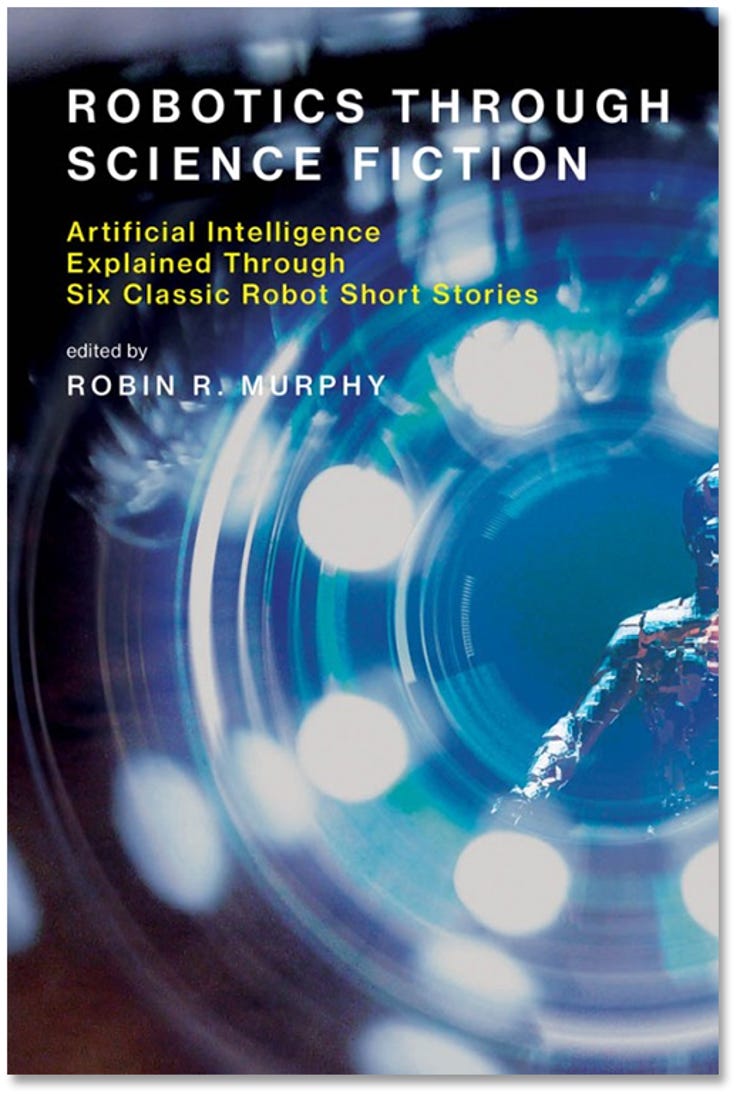Robotics Through Science Fiction, book review: New insights from old stories


Robotics Through Science Fiction: Artificial Intelligence Explained Through Six Classic Robot Short Stories •By Robin R. Murphy • MIT Press • 190 pages • ISBN: 978-0-262-53626-4 • £20 / $25
Reading classic science fiction can be a frustrating experience, particularly if you're old enough to remember when everything seemed possible. Now, after fifty years, we know the moon landing hasn't led to routine space travel. Fifty-one years after Arthur C. Clarke created HAL for Stanley Kubrick's film 2001: A Space Odyssey (1968), we have nothing like its artificial intelligence -- good or evil -- on tap. And 80 years after Isaac Asimov began writing stories about human interactions with intelligent, self-directed robots, the best we can do is autonomous cars whose human safety drivers regularly have to take over.
However, to the pioneering roboticist Robin R. Murphy, a founder of the fields of rescue robotics and human-robot interaction, classic science fiction offers a launchpad for discussions of the fundamental problems of AI and robotics. In Robotics Through Science Fiction, she selects six short stories written between 1941 and 1974 to illustrate key topics in robotics. For each story, she provides an introduction with suggestions of what to look for while reading and a discussion of the main principles illustrated by the story. She also gives each story a "reality" grade (Philip K. Dick, whose fiction seems most closely to fit our chaotic times, scores a C-, while Asimov, writing in the 1940s, is consistently high-scoring).
Murphy concludes with an overall discussion, in which she notes important topics that are missing: how robots perceive the world; how teams and swarms of robots work; and the wide variety of robot designs. As Murphy writes, all but one of the stories' robots are ground robots, yet they are all more or less humanoid, whereas today's ground robots may be anything from a Roomba to cockroach, depending on the function they're designed for.
Six stories
So, the six stories. Three are by Isaac Asimov: Stranger in Paradise (1974), Runaround (1941), and Catch That Rabbit(1944). The others are Long Shot by Vernor Vinge (1972), Supertoys Last All Summer Long by Brian Aldiss (1967), and Second Variety by Philip K. Dick (1953). Given the amount of Asimov's output about robots and his love of constructing puzzles about their behaviour for his roboticists to solve, it's not surprising he got half the list. However, none mentions the Three Laws of Robotics, still frequently referenced at robotics conferences. Of the stories, Supertoys may be the best known, as it formed the basis for the AI movie Stanley Kubrick planned to make that was completed and filmed after his death by Steven Spielberg, who released it as A.I. Artificial Intelligence in 2001. Murphy describes it, in part, as a story of "unrecognised sentience"; once a being has been called a 'robot', humans will be slow to shake that label.
SEE: How to implement AI and machine learning (ZDNet special report) | Download the report as a PDF (TechRepublic)
I learned a lot about the challenges and limitations of robotics from reading this book, despite being familiar with at least two of the stories and knowing Dick's work well enough to be able to predict the likely outcome of Second Variety. The Vinge story leads Murphy into a discussion of testing and validation, and how a system may compensate for its own failure, while the Aldiss story leads to a discussion of the differences in programming 'open world' and 'closed world' machine-learning systems.
Highly recommended for anyone who wants to gain a realistic understanding of why this stuff is harder than the hype would have you believe.
RECENT AND RELATED CONTENT
MASH for millennials: A robotic trauma center in a backpack
16-year-old engineer wins $75K at top science fair
How iRobot used data science, cloud, and DevOps to design its next-gen smart home robots
Repairing dead satellites with robots
Photos: 16 books about AI, robotics, automation, and how they're affecting the job market (TechRepublic)
Read more book reviews
- YouTubers, book review: In search of authenticity
- Custodians of the Internet, book review: Content moderation under the microscope
- The Blockchain and the New Architecture of Trust, book review: Driving networks to consensus
- The W.E.I.R.D. CEO, book review: Leadership in the AI age
- The Curse of Bigness, book review: Breaking up should be easy to do